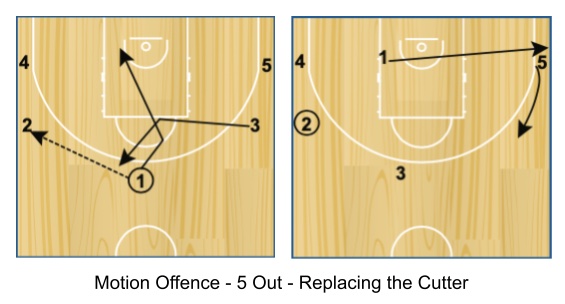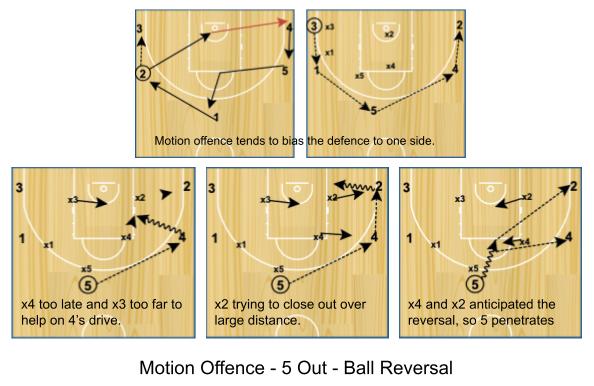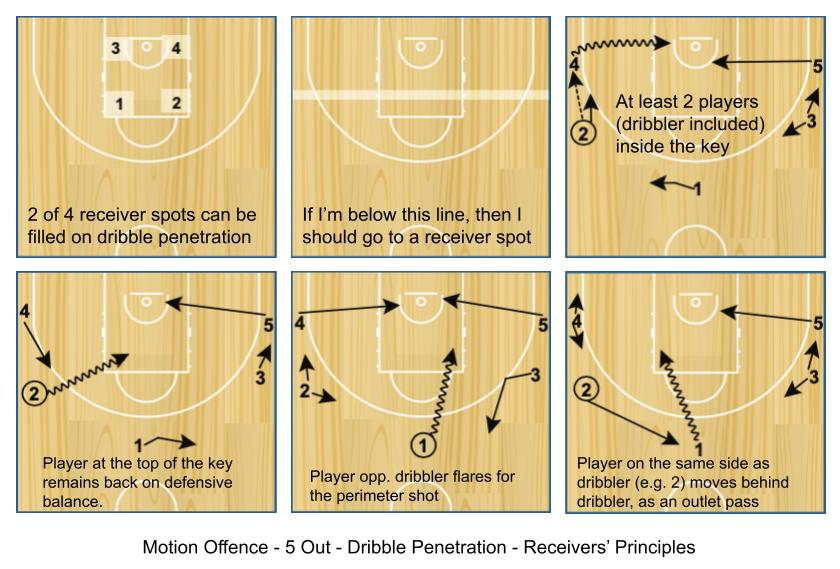Offensive Playmaking and Scoring
tracks the following play types: transition, isolation, pick & roll ball handler, pick & roll roll man, post up, spot up, handoff, cut, off screen and put-backs.
Offensive Moves
The First Step
The first step should be quick, explosive and in the direction that you wish to go. Many players' first step goes nowhere or moves them in the opposite direction, and this is typically because of not being in a low and balanced stance.
Before I learned the art, a punch first step was just a punch first step
, and a kick, just a kick. After I learned the art, a punch first step
was no longer a punch first step , a kick, no longer a kick. Now that I
understand the art, a punch first step is just a punch first step and
a kick is just a kick. The height of cultivation is really nothing special. It
is merely simplicity; the ability to express the utmost with the minimum.
Finishing At the Rim
Misdirections (e.g. in-and-out fakes) before the gather are useful for getting the defender to change their momentum (and thus out of position).
Think of all of those times when as a defender, you felt you could have blocked or altered the shot if only you were in a position to challenge it. Coach used to always talk about split-second decisions. Noticing a change in your defenders momentum and reacting to it is too small a window for you to start thinking about it.
A fellow player showed me a dribble move that he attributes to James Harden. I don’t know its canonical name, which makes it hard to get a tutorial. The gist is:
- Dribble with the left
- As you cross over the ball to the right
- Take a step with your left foot.
- Push off the left foot.
- Ball gets to your right hand, and you have momentum from the left-foot push-off.
There are a couple of gathers available: euro step to evade a defender, jump stop for pivoting/shooting options, pro-hop (euro step + jump stop, with a rip of the ball to the opposite side of the body), pro-hop euro step (pro-hop + euro step - jump stop), two-feet takeoff (more balance, power, and control of jump direction esp. to avoid shot blockers ), and over-the-head (getting past a defender while protecting the ball).
Show the ball to the defender to get them out of position (e.g. show ball upward to make the defender jump early), and then extend away (especially to do a reverse layup where you can use the rim to shield the ball). In addition to getting the defender to bite early, swinging the ball provides momentum to get some spin on the ball.
It’s important to keep your eyes on the rim.
How are you going to see potential dishes? Granted, I typically don’t see Kyrie dishing out on his layups.
This might also be helpful as a defender. If the player I’m guarding has their eye on the rim, then playing on-ball makes more sense. If they’re looking elsewhere, then I might be able to deflect a potential dish.
But again, the rim is a constant. Won’t it provide a greater advantage to note your relative position to the rim, and then observe the defense’s reaction? Or is this sort of observation best reserved for peripheral vision?
Use your momentum wisely depending on defender’s position. Bump them such that they can’t jump and block you. If you’re slightly ahead, try slowing down a bit to create this contact. If they’re slightly ahead, use a delayed step to get them to move past you.
Finish off your off-foot to throw off the defenders' timing. Especially helps if you can finish with your off-hand (including floaters). Often, you don’t need to jump upwards; you need to beat the defender to the glass.
Offensive Tactics and Strategies
Offensive Movement
Motion offense is pretty common in pickup games. Learning the principles behind it should help me read the floor better and shoot high-percentage shots.
The meta seems to be a 5-out offensive setup, where players occasionally cut to the basket.

Notice how the movement involve some initial cut into a threatening position, and not just a straight line. In general straight line cuts make sense when your defender has their back to you and therefore can’t see you.
I remember reading somewhere that change in pace is also potent. I frequently make the mistake of only focusing on raw pace, which tires me out fast.

As a dribbler: go at your defender’s hip; be a scorer first; get both feet in the paint; jump stop; shot/foot fake to create penetration opportunities.
The “jump stop” part surprised me. Maybe that’s because if I keep dribbling in the key, then the ball will get stolen?

Pick & Roll Ball Handler
Had limited success in P&R ball handler plays today. Coach always used to tell me to brush the shoulder of the screener. I don’t remember doing that, so maybe that’s why the P&R ball handler plays were ineffective. Luckily, we had a lights out 3pt shooter.
Options: penetrate the paint ready to shoot/pass; split between the two defenders; shoot a runner; step-back if on-ball defender goes under the screen.
“Dribble” is conspicuously missing. Dribbling in the paint will probably lead to a turnover.

Tip: drive hard to create separation.
Hard drives prompt the defender to commit, which frees up other options.
Often, a “big” sets the screen for the ball-handling guard.
Creates a room for mismatches that can be exploited. Furthermore, if the big is not involved, then the paint will probably be too crowded.
A common mistake I make is always going for a hard drive after a screen. I’m not tall/athletic enough to finish at the rim against a big. Furthermore, if the big is coming for me, then my big has a mismatch!
Defense
Compete every possession. Need to have a care factor.
Physical attributes, e.g. lateral movement.
Know what the opponent wants to do, e.g. do they tend to shoot off a left dribble; where do they [actually] want to go.
Thinking costs you precious half-seconds, that make the difference between a pass interception, and an open look from the opponent. Anticipate. Rondo and LeBron are prime examples of this sort of awareness.
Role Models
NBA 2K probably does a decent job rating the in-season players, given their close association with the NBA itself. Given the badges that I think suit my play-style, which players should I pay attention to?
Badge descriptions obtained from . Badge icons obtained from . Players to watch compiled from by searching for current PGs and SGs.
Finishing
Badges:






Stephen Curry, James Harden, Trae Young, Chris Paul, Damian Lillard, Donovan Mitchell, Devin Booker, Kyrie Irving, Ja Morant, Shai Gilgeous-Alexander, De’Aaron Fox, Fred VanVleet
Shooting







Stephen Curry, Damian Lillard, Matt Thomas, Trae Young, Devin Booker, Bradley Beal, James Harden, C. J. McCollum, Chris Paul, Donovan Mitchell, E’Twaun Moore, Avery Bradley, Fred VanVleet, Frank Ntilikina, Shai Gilgeous-Alexander
Expected Harden to rank higher. Was unaware of Matt Thomas.
Playmaking








Stephen Curry, Damian Lillard, Kyrie Irving, James Harden, Trae Young, Chris Paul, Bradley Beal, Devin Booker, Shai Gilgeous-Alexander
Defense / Rebounding



Stephen Curry, Chris Paul, Jrue Holiday, Marcus Smart, T. J. McConnell, Klay Thompson, Patrick Beverly, Frank Ntilikina
Watching Film
Watching film is a good way of training my mental basketball model. has a couple.
However, it’d be great if I could get the POV of a given player, e.g. how do pro PGs read the offense and create opportunities? Currently, select NBA players mic up for a game, but we’re probably a far way off from players donning POV cameras (unless Oculus’s partnership with the NBA is looking into this).
Maybe computer vision techniques can provide approximations of player POVs? Some of the building blocks exist, e.g. object detection, player models (albeit in closed-source and trade-secrets of NBA 2K), full game archives , etc. Or maybe Basketball - Synergy Sports has one in the works?
On software approaches: detected foul events and shot events; detected and classified screening patterns. Much of the research is in event detection.
has 300K+ subscribers on YouTube, and I liked his breakdown of Kyrie’s finishing. Should be a good resource for distilled film insights.
References
- Players Play Type | Stats. www.nba.com . Accessed Sep 6, 2021.
- Schuhmann Film Studies: Breaking down the NBA's best teams. www.nba.com . Jul 30, 2020. Accessed Sep 6, 2021.
- Film Study: Mavs' efficient offense still has room to improve. www.nba.com . Jul 13, 2020. Accessed Sep 6, 2021.
- FIBA Coaches Manual > Offensive Tactics and Strategies > Screening. wabc.fiba.com . Accessed Jul 15, 2021.
- FIBA Coaches Manual > Offensive Tactics and Strategies > Offensive Movement. wabc.fiba.com . Accessed Jul 15, 2021.
- Alex Caruso on What He Learned From LeBron James That He Took With Him To Chicago. JJ Redick; Tommy Alter; Alex Caruso. www.youtube.com . Accessed Nov 14, 2021.
- FIBA Coaches Manual > Offensive Moves. wabc.fiba.com . Accessed Jul 15, 2021.
- Bruce Lee on Twitter: '🐲 ‘Before I learned the art, a punch was just a punch, and a kick, just a kick. After I learned the art, a punch was no longer a punch, a kick, no longer a kick. Now that I understand the art, a punch is just a punch and a kick is just a kick. 1/. twitter.com . Accessed Dec 5, 2021.
- Next Gen Badges. www.nba2klab.com . Accessed Dec 5, 2021.
- NBA 2K22 | 2KDB All Players List. 2kdb.net . Accessed Dec 6, 2021.
- Multimodal Semantic Analysis and Annotation for Basketball Video. Song Liu; Min Xu; Haoran Yi; Liang-Tien Chia; Deepu Rajan. EURASIP Journal on Advances in Signal Processing. doi.org . www.connectedpapers.com . 2006.
- Recognizing tactic patterns in broadcast basketball video using player trajectory. Hua-Tsung Chen; Chien-Li Chou; Tsung-Sheng Fu; Suh-Yin Lee; Bao-Shuh P. Lin. Journal of Visual Communication and Image Representation, Vol. 23, No. 6, pp. 932 – 947. doi.org . www.connectedpapers.com . scholar.google.com . 2012.
- A Survey of Content-Aware Video Analysis for Sports. Huang-Chia Shih. IEEE Transactions on Circuits and Systems for Video Technology, 28(5), 1212–1231. doi.org . www.connectedpapers.com . scholar.google.com . 2018.
- By Any Means Basketball - YouTube. Coleman Ayers. www.youtube.com . www.byanymeansbball.com . Accessed Jan 15, 2022.
- Kyrie's Finishing: A Complete Breakdown - YouTube. Coleman Ayers. www.youtube.com . Apr 3, 2018. Accessed Jan 15, 2022.
- Basketball moves - Wikipedia. en.wikipedia.org . Accessed Jan 15, 2022.
Objective: Learn to read the game and make smart predictions. Reaction times are overrated; perception and prediction rule .